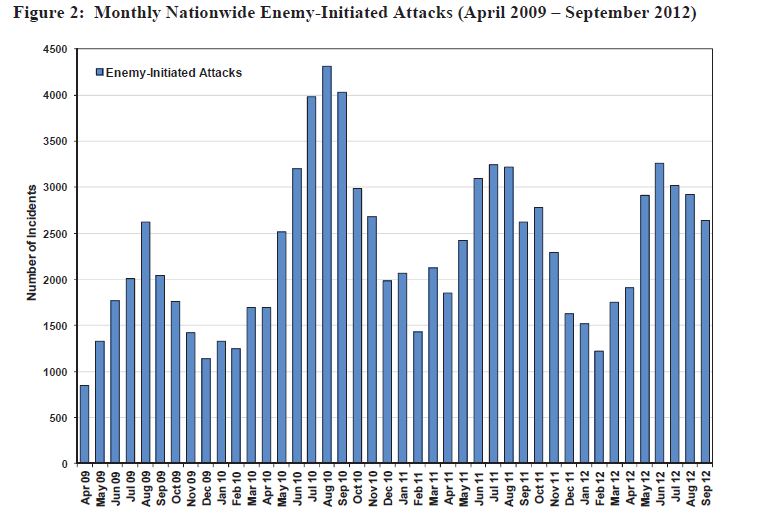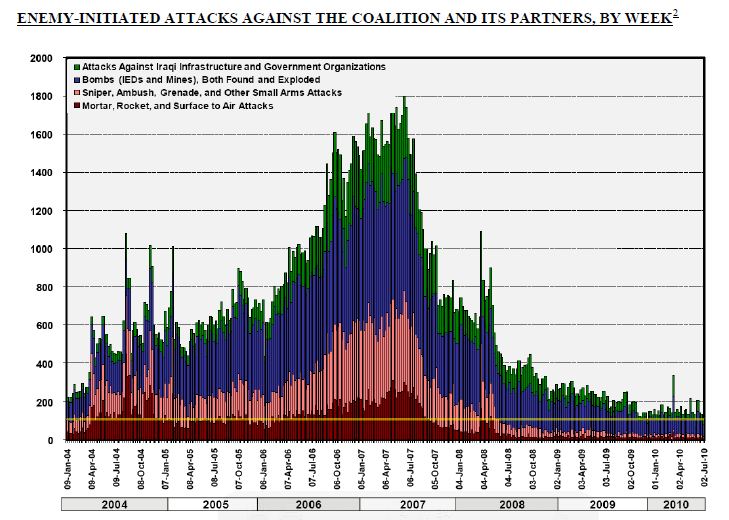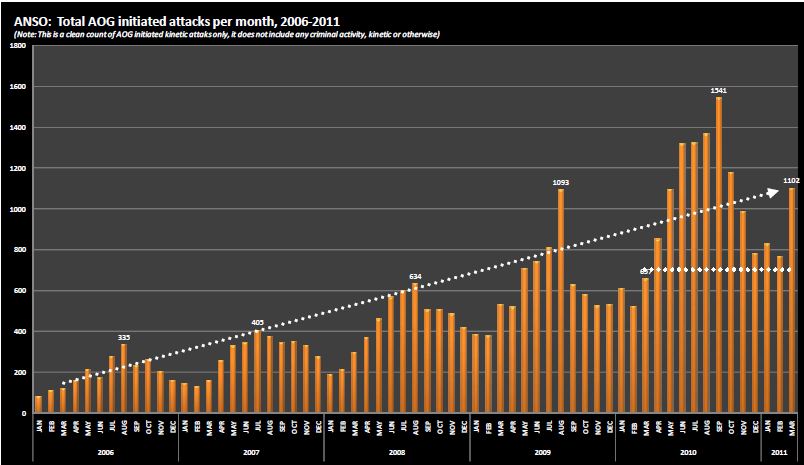2012 Afghan Fighting Season Data Are In: Daniel Davis Was Right on Surge Failure
As the “fighting season” for the tenth full year of US forces being in Afghanistan comes to a close, the Defense Department has released its most recent report (pdf, required every Friedman Unit by law) on “progress” in the war. Although the military does its best, as always, to couch its report in language describing progress against goals which always must be redefined in order to claim any progress, those who have been paying attention knew from the report prepared early this year by Lt. Col. Daniel Davis that the vaunted surge of troops in Afghanistan, despite being billed as guaranteed to work as well as the Iraq surge, has been a complete failure.
Here are the latest results on enemy initiated attacks, on a monthly basis:
Note that in order to not remind us of how violence escalated in Afghanistan while our troops were present, this figure cuts off the early years of the war. A similar chart, with the early years included (but showing events on a daily basis rather than monthly, so the scale is different) can be seen in this post from early last year. However, by cutting off the early years, the Defense Department allows us to concentrate on the surge and its abject failure. Obama’s surge began with his order in December, 2009, so this graph gives us 2009 as the base on which to compare results for the surge. Despite a small decrease in violence from the peak in 2010, both 2011 and 2012 are worse than 2009, the last pre-surge year.
But how could the surge fail? Recall the “awesome” results from the Iraq surge (pdf). That eighteen month surge ended in July of 2008:
Daniel Davis explains how the reduction in violence in Iraq was unrelated to the surge or Petraeus’ vaunted COIN strategy. From my February post on the Davis report:
Once we realize the fact that the surge in Afghanistan has not worked, the natural question arises of why it didn’t since the Iraq surge is so widely credited with turning around the violence trend there. After all, both surges have been sold as the model for the new COIN centered around the idea of protecting the population.
The answer here is that we were sold lies about the underlying forces behind the decrease in violence in Iraq. In short, violence decreased for reasons mostly unrelated to the surge and the new COIN approach. From page 57:
“As is well known, the turning point in 2007 Iraq came when the heart of the Sunni insurgency turned against al-Qaeda and joined with US Forces against them, dramatically reducing the violence in Iraq almost overnight. The overriding reason the Sunni insurgency turned towards the United States was because after almost two years of internal conflict between what ought to have been natural allies – al Qaeda in Iraq (AQI) and the greater Sunni insurgency – a tipping point was reached whereby the Iraqi Sunnis finally and decisively turned against AQI. Had this unnatural split not occurred, by all accounts I have been given on both the Iraqi side and the US military side, “we would still be fighting in Iraq today,” in the words of two officers I know who fought there.”
There simply has been no turning against insurgents in Afghanistan in the same way there was in Iraq. The COIN strategy has been the same in both places, so it is impossible to escape the conclusion that the military’s current version of COIN alone is insufficient to end violence in Afghanistan.
The Petreaus-Allen-Broadwell-Kelley scandal very conveniently will prevent this evidence of failure receiving the attention it deserves. Should Congress decide to take a realistic look at Afghanistan, it’s hard to see how they can conclude anything other than that our presence has accomplished nothing but death and destruction. Getting out now rather than two years from now is the only responsible decision.



